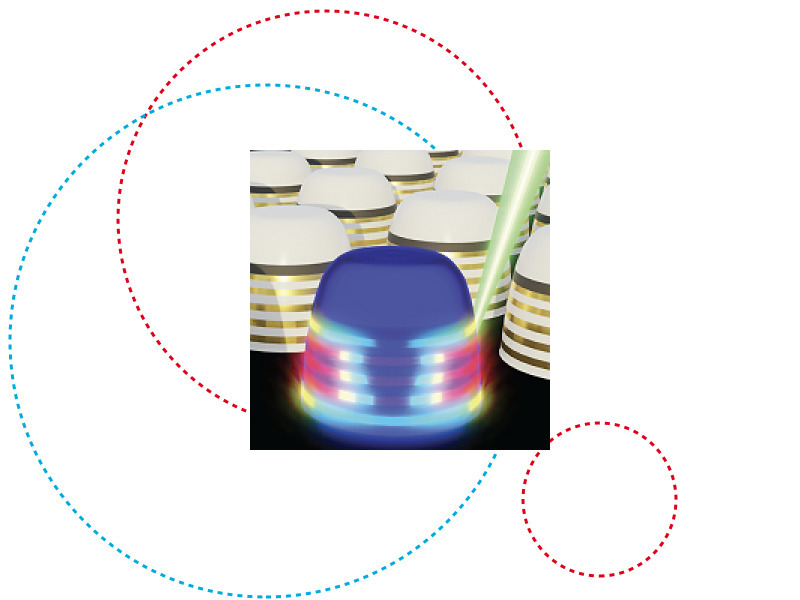Physicists from the University of Luxembourg in collaboration with international partners from Sweden, USA and Italy have reported on a novel magnetically tunable optical effect in a special kind of artificial materials, called hyperbolic metamaterials, displaying nontrivial optical properties, such as conductive behaviour along particular spatial directions and insulating behaviour along others. The scientists have published their findings in Physics Review Letters, the world’s premier physics letter journal and the American Physical Society’s flagship publication with the mission to advance and diffuse the knowledge of physics.
Computational workloads continue to grow due to the massive rising amount of information. In addition, the increasingly use of electronic devices has an undeniable impact on our environment. For instance, data centres, which are ubiquitous in our society and process both our public and personal data, are filled with servers that contain chips to process the information. The extensive use of these data servers, not only contribute to carbon emission, but is also energy demanding. This happens because current electronic technologies are highly dissipative. They are also limited in speed and power.
To tackle the increasing demand for faster, more powerful, and energy-efficient data storage and processing capabilities, we need to discover and develop alternative solutions. Nanophotonics uses light polarization as an information carrier in optical communications, sensing, and imaging. Likewise, the state of polarization plays a key role in the photonic transfer of quantum information. In this framework, optical nanodevices enabling the dynamic manipulation of light polarization at the nanoscale are key components for future nanophotonic applications.
For instance, active nanophotonics can be realised by controlling the optical properties of materials with magnetic fields. Materials with broadband tunable magneto-optical response are therefore highly desired for various components in next-generation integrated photonic nanodevices for a wide range of applications, from single-molecule detection to quantum computing. Concurrently, hyperbolic metamaterials received a lot of attention in the past decade since they exhibit unusual properties that are rarely observed in nature and provide an ideal platform to control the optical response at the nanoscale via careful design of the effective permittivity tensor, surpassing the possibilities of conventional systems.
“Light polarization rotators and nonreciprocal optical isolators are essential building blocks in photonics technology, which is most likely going to replace electronics in the future, as light is much faster and less energy consuming than electrons. These passive devices are commonly based on magneto-optical effects. Magnetoplasmonics, the combination of magnetism and plasmonics, is a promising route to bring these devices to the nanoscale. In this work, we have studied a novel family of artificial metamaterials for highly tunable active magnetoplasmonics, in which we can tailor the magneto-optical response over a broad spectral range” explains Nicolò Maccaferri, lead scientist of the work and Researcher in the Ultrafast Condensed Matter Physics Group led by Prof. Daniele Brida at the Department of Physics and Materials Science at the University of Luxembourg.
“Controlling magneto-optical effects on the nanoscale is crucial for reducing the size of key photonic devices based on the non-reciprocal propagation of light and to enable active nanophotonics. Here, we disclose a currently unexplored approach that exploits the influence of optical anisotropy in non-magnetic hyperbolic nanoparticles on their magneto-optical activity. We demonstrate that the magneto-optical response is driven by the exotic nature of hyperbolic dispersion” continues Maccaferri.
The work has been funded by the Luxembourg National Research Fund Agency under the CORE Scheme. The project ‘ULTRON’, led by Maccaferri, has the main scope to obtain a coherent hybridization of optical and magnetic excitations in metamaterials, and disclose a new mechanism to develop future light-driven ultrafast, ultra-dense and energy-efficient data processing technologies working at even higher speeds than electronics.
“These results were obtained in the framework of our CORE project ‘ULTRON’ are really important since they represent another step towards a full control over magnetic and optical degrees of freedom by using metamaterials” concludes Maccaferri.
Original publication: “Magneto-Optical Activity in Nonmagnetic Hyperbolic Nanoparticles” Joel Kuttruff, Alessio Gabbani, Gaia Petrucci, Yingqi Zhao, Marzia Iarossi, Esteban Pedrueza-Villalmanzo, Alexandre Dmitriev, Antonietta Parracino, Giuseppe Strangi, Francesco De Angelis, Daniele Brida, Francesco Pineider, and Nicolò Maccaferri, Physical Review Letters, November 2021.
For additional information about metamaterials, see also the TEDxUniversityofLuxembourg “Metamaterials matter: the smart materials of the future” .
